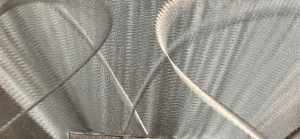At Oios Metals, we are huge fans of stainless steel. Stainless steel appliances have grown immensely popular in the past few years for their beauty and the fact that the metal does not stain. We use recycled steel in our custom designed furnishings for the same reasons. Since it is such a large part of our lives, here are some facts about stainless steel from Anne Marie Helmenstine, Ph.D., About.com Guide:

What Is Stainless Steel and Why Is it Stainless?
In 1913, English metallurgist Harry Brearly, working on a project to improve rifle barrels, accidentally discovered that adding chromium to low carbon steel gives it stain resistance. In addition to iron, carbon, and chromium, modern stainless steel may also contain other elements, such as nickel, niobium, molybdenum, and titanium. Nickel, molybdenum, niobium, and chromium enhance the corrosion resistance of stainless steel.
It is the addition of a minimum of 12% chromium to the steel that makes it resist rust, or stain ‘less’ than other types of steel. The chromium in the steel combines with oxygen in the atmosphere to form a thin, invisible layer of chrome-containing oxide, called the passive film.
The sizes of chromium atoms and their oxides are similar, so they pack neatly together on the surface of the metal, forming a stable layer only a few atoms thick. If the metal is cut or scratched and the passive film is disrupted, more oxide will quickly form and recover the exposed surface, protecting it from oxidative corrosion.
(Iron, on the other hand, rusts quickly because atomic iron is much smaller than its oxide, so the oxide forms a loose rather than tightly-packed layer and flakes away.)
The passive film requires oxygen to self-repair, so stainless steels have poor corrosion resistance in low-oxygen and poor circulation environments. In seawater, chlorides from the salt will attack and destroy the passive film more quickly than it can be repaired in a low oxygen environment.
Types of Stainless Steel
The three main types of stainless steels are austenitic, ferritic, and martensitic. These three types of steels are identified by their microstructure or predominant crystal phase.
Austenitic:
Austenitic steels have austenite as their primary phase (face centered cubic crystal). These are alloys containing chromium and nickel (sometimes manganese and nitrogen), structured around the Type 302 composition of iron, 18% chromium, and 8% nickel. Austenitic steels are not hardenable by heat treatment. The most familiar stainless steel is probably Type 304, sometimes called T304 or simply 304. Type 304 surgical stainless steel is an austenitic steel containing 18-20% chromium and 8-10% nickel.
Ferritic:
Ferritic steels have ferrite (body centered cubic crystal) as their main phase. These steels contain iron and chromium, based on the Type 430 composition of 17% chromium. Ferritic steel is less ductile than austenitic steel and is not hardenable by heat treatment.
Martensitic:
The characteristic orthorhombic martensite microstructure was first observed by German microscopist Adolf Martens around 1890. Martensitic steels are low carbon steels built around the Type 410 composition of iron, 12% chromium, and 0.12% carbon. They may be tempered and hardened. Martensite gives steel great hardness, but it also reduces its toughness and makes it brittle, so few steels are fully hardened.
There are also other grades of stainless steels, such as precipitation-hardened, duplex, and cast stainless steels. Stainless steel can be produced in a variety of finishes and textures and can be tinted over a broad spectrum of colors.
Passivation
There is some dispute over whether the corrosion resistance of stainless steel can be enhanced by the process of passivation. Essentially, passivation is the removal of free iron from the surface of the steel.
This is performed by immersing the steel in an oxidant, such as nitric acid or citric acid solution. Since the top layer of iron is removed, passivation diminishes surface discoloration.
While passivation does not affect the thickness or effectiveness of the passive layer, it is useful in producing a clean surface for a further treatment, such as plating or painting. On the other hand, if the oxidant is incompletely removed from the steel, as sometimes happens in pieces with tight joints or corners, then crevice corrosion may result. Most research indicates that diminishing surface particle corrosion does not reduce susceptibility to pitting corrosion.
Source: http://chemistry.about.com/cs/metalsandalloys/a/aa071201a.htm

